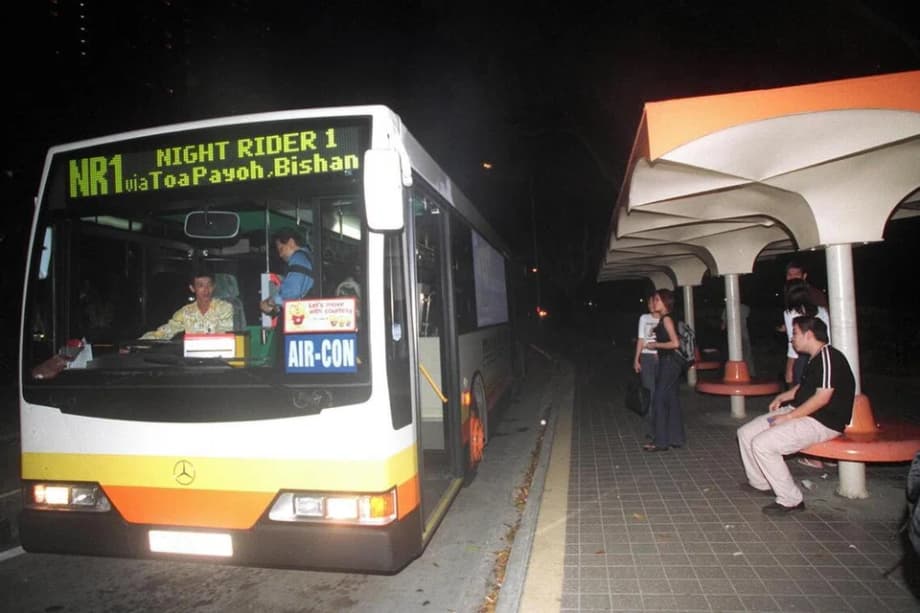Late night transport shaped how Singapore went out
For more than two decades, Singapore’s NightRider buses made late evenings in the city centre feel accessible. The network linked nightlife clusters in the core with large housing estates, running after midnight on weekends and the eves of public holidays when regular buses and trains had stopped. For students, service staff, and partygoers, a flat fare trip from the bars of Clarke Quay or the clubs off Orchard Road to the heartlands was a familiar end to the night.
- Late night transport shaped how Singapore went out
- Why NightRider and Nite Owl stopped in 2022
- What has filled the gap since
- Nightlife, workers, and the cost of getting home
- How other cities keep people moving after midnight
- Can Singapore be a 24 hour city without affordable night transport
- Costs, maintenance and neighborhood impact
- Ideas on the table: from private buses to targeted pilots
- The Essentials
Affordable rides mattered. NightRider gave patrons the confidence to stay out longer, move between venues, and still get home at a price that did not overshadow the evening’s budget. It also helped night shift workers in hospitality and cleaning, whose jobs often finish long after the last train. A bus every 20 to 30 minutes might not have been perfect, yet it set a reliable baseline that anchored how people planned a night out.
That anchor is gone. The service, suspended during the COVID 19 pandemic, was formally discontinued in 2022. Since then, late night travel has leaned on ride hailing and taxis, with prices that spike when everyone leaves at once. The end of NightRider changes how Singapore plays and works after midnight, and it is reshaping the debate on what a 24 hour city should look like here.
Why NightRider and Nite Owl stopped in 2022
NightRider began with NR1 in March 2000 and grew quickly. At its height in 2001, there were 22 overnight routes. Many early additions were pulled back because demand did not hold. By 2020, only six NightRider services remained, and all were suspended in April 2020 as nightlife shut during the pandemic. On June 30, 2022, the operator confirmed the permanent withdrawal of NR1, NR2, NR3, NR5, NR6 and NR8. On the same date, the city’s other overnight network, the Nite Owl services run by SBS Transit, also ended.
These buses had a clear design. They ran after midnight on Fridays, Saturdays and on the eves of public holidays. Services typically came every 20 or 30 minutes. Fares, which started at about S$3 in the early years, rose over time to S$4.50. There were free transfers between NightRider routes for fare card users within a short window, and from 2014 the surviving routes ran one way from the city to the estates with earlier last buses.
The Land Transport Authority (LTA) cited low ridership, the availability of alternatives, financial prudence, and the need to preserve scarce maintenance hours for both buses and rail as reasons for not reinstating the services. The 2022 decision came as part of a broader rationalisation that also saw special routes such as 188R and 926 discontinued, with travel alternatives provided via rail and other buses.
What has filled the gap since
Late night travel now leans on taxis and private hire cars. That can work on quieter nights, yet it becomes costly during peaks and when rain hits. Midnight surcharges for taxis and dynamic pricing for private hire cars push fares up, so friends split rides or leave early to keep costs down. Staff who finish after closing bear the same price pressure, which can make late shifts harder to fill and more expensive for businesses to support.
One private operator has tried to step into the space. In January 2023, A&S Transit launched two city to heartland routes on Fridays, Saturdays and the eves of public holidays. The first bus leaves Shenton Way at 11.30 pm, the last departs at 2.30 am. NS-1 runs through the central business district, Clarke Quay and Orchard, then up to Ang Mo Kio, Hougang, Sengkang and Punggol. NS-2 goes via River Valley, Orchard and Newton, then Yishun and Sembawang before ending in Woodlands. The fare is S$4.50 by stored value card or S$5 in cash, with buses scheduled every 45 minutes and no standing allowed.
These services show demand is present on busy nights, but they remain limited in coverage and frequency. The LTA has said it is open to new proposals from private operators. A citywide, frequent, affordable network has not returned, and late night mobility remains dependent on private point to point options.
Nightlife, workers, and the cost of getting home
The change hits two groups hardest. Hospitality workers, cleaners and security staff often finish after 1 am. Without an affordable option, they face high surcharges or long walks to fewer, more distant pick up points. Employers either raise allowances, shorten late shifts, or accept staff shortages. Each choice pushes up costs or reduces hours, which can make marginal operations in the downtown core less viable.
Customers feel it too. When the last train leaves just after midnight and the next dependable option is a surging private hire fare, many people choose one venue for the night or cut evenings short. That erodes the casual movement between places that fuels bar clusters and live music rooms. It has also helped a growing daylife scene. Cafes, day parties, and family friendly festivals offer a social outlet that sidesteps late night transport costs.
Urban geography matters. Most nightlife sits in and around the city centre. Affordable late night transport is the bridge that turns a party district into a citywide scene. Without that bridge, activity concentrates near rail nodes and in pockets reachable by foot, which can make the scene feel smaller and less flexible.
How other cities keep people moving after midnight
Different global models show that late night networks can be built in many ways. London runs 24 hour bus routes on core corridors every day and adds Night Tube service on several Underground lines on Fridays and Saturdays. These layers let workers and patrons travel across a wide area at a price that stays predictable. City Hall also runs a night time economy program and funds projects to help districts manage crowds, transport and safety.
New York keeps its subway open all day, every day. The system has its own challenges, yet round the clock rail means people can expect an affordable ride at any hour across the five boroughs. That steadiness supports both nightlife and essential services, from hospitals to logistics warehouses.
Hong Kong does not run its MTR all night, but it fields an extensive network of night buses and overnight minibuses that map to key corridors and residential districts. Tokyo, which has strong taxi coverage and first trains starting early, has moved to promote night culture through new programs. Many cities now appoint a night mayor to coordinate transport, safety, licensing and public space use after dark, recognizing the night time economy as a distinct part of city life.
Can Singapore be a 24 hour city without affordable night transport
Singapore has a lively supper culture, with late eateries and round the clock venues that cater to shift workers and night owls. The airport, port and many logistics and healthcare operations keep the city working through the night. However, for entertainment and dining beyond the core, public transport largely stops soon after midnight. That gap raises the cost of staying out and dilutes the sense that the city runs without pause.
Planning decisions shape the experience. New towns are designed for live, work and learn, not for nightlife. Entertainment clusters were built in the city centre, which makes sense for access and control. That pattern raises the stakes for affordable transport out of the core. Without it, a night out becomes a premium purchase rather than a normal part of urban life.
The label of a 24 hour city is more than late opening hours. It rests on mobility, safety and cost. If movement after midnight is reliable and affordable, more people will work and play across the city at those hours. If movement is expensive and scarce, the night feels narrower and more exclusive.
Costs, maintenance and neighborhood impact
Public transport cannot run forever without rest. LTA has highlighted the need to protect maintenance windows and to use finite resources where demand is highest. That is not abstract. Tracks, power systems and signals need overnight attention, and buses need checks. There are also neighborhood concerns about noise, litter and late night crowding on residential streets.
Maintenance windows and operations
Rail systems rely on overnight closures to replace rails, inspect cables and test equipment. Compressing those windows can raise the risk of faults the next day. Bus operators also need time to service vehicles and manage driver rosters within legal duty limits. Late night service adds costs for staffing and fleet, and when ridership is thin, fare revenue may not cover operations. That is why many cities focus late night service on weekends and peak nights, or they limit routes to a few high demand spines that still allow broad coverage. Singapore has extended last train departures on special occasions and can time targeted operations to manage demand bursts without overstretching maintenance teams.
Noise, safety and demand management
Lively streets after midnight can affect residents near arterial roads. Managing queues, pickups and dispersal needs planning, lighting and enforcement. Cities that run strong night networks also invest in crowd stewards, taxi marshals and clear signage for late night routes. Well run late night transport lowers conflicts and improves safety by keeping people moving quickly from entertainment streets to homes. The right design can route buses along wider roads, space stops to reduce residential noise, and coordinate departures with venue closing times.
Ideas on the table: from private buses to targeted pilots
There is no single fix, but a set of practical steps could restore affordability without undermining maintenance and neighborhood rest. The goal is a simple, predictable ladder of options that scale with demand on the busiest nights and corridors.
- Reintroduce a small set of night trunk routes on Fridays, Saturdays and eves of public holidays, linking the city centre to major interchanges in the north, northeast, east and west, with departures every 30 minutes.
- Extend last train timings by 30 to 60 minutes on selected lines on key nights, coordinated with night trunk buses at major interchanges for onward travel.
- Partner with private operators to expand coverage like NS-1 and NS-2, unify branding and timetables, and allow open payment methods so riders pay one clear fare.
- Create a night worker pass that gives discounted rides on designated night services for hospitality and essential staff finishing after 1 am.
- Designate temporary late night pickup lanes near entertainment streets with marshals and clear signs to shorten wait times and reduce surge pricing.
- Trial on demand shuttles from nightlife zones to interchanges using geofenced stops and pooled bookings, with published performance targets and an independent evaluation.
- Plan routes along wider corridors away from homes where possible, and invest in quiet bus technology and stop design that reduces noise.
Each step can be piloted for a fixed period and measured on cost recovery, ridership and safety. If demand holds, the network can be scaled. If it falls short, services can be adjusted or wound down with transparent data so commuters and operators understand the trade offs.
The Essentials
- NightRider and Nite Owl services ended on June 30, 2022 after low ridership, available alternatives and the need to preserve maintenance windows.
- The network peaked at 22 routes in 2001, then shrank to six by 2020. Services ran after midnight on weekends and eves of public holidays, with fares rising to S$4.50.
- Since 2022, late night travel depends on taxis and private hire cars. Prices surge at peak dispersal times and in bad weather.
- A&S Transit launched two private routes, NS-1 and NS-2, in January 2023 with S$4.50 fares by card, 45 minute frequencies and limited coverage.
- London uses 24 hour buses and a weekend Night Tube, New York runs a 24 hour subway, and Hong Kong fields extensive night buses and minibuses.
- LTA points to scarce maintenance hours and finite resources as reasons not to run widespread late night public services.
- Operators report cost and staffing pressures for late shifts, while patrons curb venue hopping and shift toward daylife activities.
- Targeted options include a small set of night trunk routes, limited train extensions on peak nights, private partnerships, and on demand shuttles tied to interchanges.




